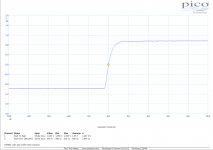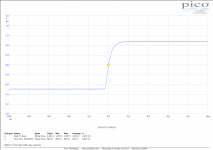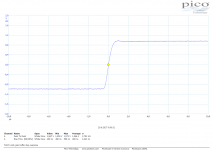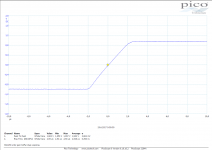What is remarkable is that the 1458 holds up so well in this test.
Yes it is, I have been thinking about that, as well as about the excellent score of the TL072.
But try to imagine how people listen to these files. You try to find the one you prefer. You hear a bunch that pretty much sounds the same, but one that stands a bit out.
I think it would be pretty much impossible NOT to select the one that stands out. What else would you do? Disregard the one that stands out and randomly pick one from the bunch that all sound pretty much the same?
I think the chances are overwhelming that the one that stands out will be selected, unless it sounds really, really bad that there is obviously a fidelity issue. But that is not the case; that TL072 didn't really sound bad at all.
Jan
I'm not sure Jan. The 1458 really should have been the one to at least sound a little different simply because it is so far down the pecking order in comparison to all the other devices.
A lot of people (if just asked) would probably not rate the TL072 very highly and yet when used correctly (such as here) it seems to offer excellent sonic performance.
I wonder if more 'complex' music would have yielded a different outcome ?
A lot of people (if just asked) would probably not rate the TL072 very highly and yet when used correctly (such as here) it seems to offer excellent sonic performance.
I wonder if more 'complex' music would have yielded a different outcome ?
I'm not sure Jan. The 1458 really should have been the one to at least sound a little different simply because it is so far down the pecking order in comparison to all the other devices.
True, it should have, but the votes indicate it didn't. The votes indicate that it was the TL072 that stood out, for whatever reason.
Jan
I actually voted for the TL072 and the reasons I gave to Pavel were that it was smooth and inoffensive. That impression persisted throughout all my listening sessions.
Have a look at my comments:
http://www.diyaudio.com/forums/ever...-96-24-listening-test-opamps.html#post5118234
and the comments of Joseph K:
http://www.diyaudio.com/forums/ever...-96-24-listening-test-opamps.html#post5118424
Have a look at my comments:
http://www.diyaudio.com/forums/ever...-96-24-listening-test-opamps.html#post5118234
and the comments of Joseph K:
http://www.diyaudio.com/forums/ever...-96-24-listening-test-opamps.html#post5118424
I'm not sure Jan. The 1458 really should have been the one to at least sound a little different simply because it is so far down the pecking order in comparison to all the other devices.
A lot of people (if just asked) would probably not rate the TL072 very highly and yet when used correctly (such as here) it seems to offer excellent sonic performance.
I wonder if more 'complex' music would have yielded a different outcome ?
Karl, the measurements that I posted in
Another big opamp listening test
and
Op amps listening test with hires files
are good enough even for the 1458, there is nothing to indicate that there should be any audible difference.
Maybe if we tested at 8Vrms or gain 100x we would find different results. But it was not the case. 2Vrms is a realistic link level (8Vrms is not) and I wanted to test unity gain buffers. No one would use the 1458 in a microphone amp. There are other parts for this task.
BTW, load impedance was 3k.
I will test TL072 and MA1458 for a square response in my test circuit, if we can see any anomalies from expected behavior.
Well, I think we should be careful to try to analyze individual impressions and preferences and surely not the reasons and arguments given.
This type of test is designed to find out how 'most' people would rate the various parts. Individual votes are of interest to the individual (of course) but totally irrelevant for the test outcome; you (not specifically you Mooly) are only one small speck in the statistics. Sorry to thread on your ego, but that's the harsh truth. 😱
Secondly, because you have no access to the unconcious factors and inputs that lead to your vote, the only option to reconcile your vote with your opinions and views is to post-fact rationalize. So, whatever reasons anyone now gives for their vote is rationalisation after the fact and thus by definition untrustworthy. Again, sorry to disappoint you, but that's how things work in perception and statistical controlled testing.
I am very happy with how this test was run, thankful that participants were able to withhold comments until the test was closed to keep it blind, and I thank Pavel for the many hours that must have gone into this and its predecessors. I learned.
Jan
This type of test is designed to find out how 'most' people would rate the various parts. Individual votes are of interest to the individual (of course) but totally irrelevant for the test outcome; you (not specifically you Mooly) are only one small speck in the statistics. Sorry to thread on your ego, but that's the harsh truth. 😱
Secondly, because you have no access to the unconcious factors and inputs that lead to your vote, the only option to reconcile your vote with your opinions and views is to post-fact rationalize. So, whatever reasons anyone now gives for their vote is rationalisation after the fact and thus by definition untrustworthy. Again, sorry to disappoint you, but that's how things work in perception and statistical controlled testing.
I am very happy with how this test was run, thankful that participants were able to withhold comments until the test was closed to keep it blind, and I thank Pavel for the many hours that must have gone into this and its predecessors. I learned.
Jan
I have just measured and saved step responses of all 4 parts in the test circuit. Briefly:
- 4562 and 2134 follow exponential response of the preceding RC stages,
- 072 is seemingly fastes, but it is not, the part itself has overshoot and the result we can see is part's response convolved with the preceding RC filter stages,
- 1458 is slewing and it shows typical slew rate of 0.5V/us. Still enough 😀
So, nothing new. Just to add that the TL072 always has some stability issues and it has to be considered in the design stage. Especially it does not like capacitive loading. We have a series resistor here at the output.
- 4562 and 2134 follow exponential response of the preceding RC stages,
- 072 is seemingly fastes, but it is not, the part itself has overshoot and the result we can see is part's response convolved with the preceding RC filter stages,
- 1458 is slewing and it shows typical slew rate of 0.5V/us. Still enough 😀
So, nothing new. Just to add that the TL072 always has some stability issues and it has to be considered in the design stage. Especially it does not like capacitive loading. We have a series resistor here at the output.
Attachments
But you have to admit that the post-fact rationalisation is often great entertainment 🙂.
That's why we are all hear (or here) 😉
Jan/Pavel,
Absolutely it was a brilliant test, great fun and very informative.
What is bizarre to me is that not so long ago we were testing one make of cap vs another, and one cable vs another, stuff at the miniscule nano size edge, and now here we are pitting essentially a 741 against the best of todays offerings... and we can't bloomin' tell the difference 😀 at least not at a level you would bet on.
With regard to the TL072, I would like to think I picked it on audible merit and that the choice was based on audible perception but I agree that statistically a one off shot at this doesn't count for much.
Squarewave testing the 1458... anything over 10kHz and a couple of volts will look grim compared to all the others.
What is bizarre to me is that not so long ago we were testing one make of cap vs another, and one cable vs another, stuff at the miniscule nano size edge, and now here we are pitting essentially a 741 against the best of todays offerings... and we can't bloomin' tell the difference 😀 at least not at a level you would bet on.
Karl, I have a deep suspicion that the problem was in the technical part/preparation of the old/older tests, especially if I speak about my tests. I have found that it is not so easy to prepare "technically valid data". Small gain differences must be avoided, frequency response differences must be avoided (even the smallest ones) and time shifts between the samples/files must be minimized to the smallest possible value. Otherwise we test differences that are not a result of the subject under test. It is really not so easy as it might look at the first sight.
Squarewave result doesn't throw any real surprises. And thanks for doing this 🙂
I guess what we can take away from all of this is that for a line level buffer implemented correctly, the 1458 has been proved adequate even when using extended bandwidth material.
Makes you think.
I guess what we can take away from all of this is that for a line level buffer implemented correctly, the 1458 has been proved adequate even when using extended bandwidth material.
Makes you think.
Squarewave testing the 1458... anything over 10kHz and a couple of volts will look grim compared to all the others.
But it is totally unimportant. You have no 10kHz squares in any music signal, especially not in your mp3 transfers 😉 (sorry that I am poisonous)
Even 96/24 has nothing more than 4th harmonic of the 10kHz square. And "slew rate" of 40kHz/2Vrms sine would be 0.7Vus, but music signal will never contain 40kHz at full amplitude. The maximum expectable dv/dt of the 2Vrms music signal would be no more than 0.1V/us.
Re "more complex music" - measurements and a set of test signals always show more than music signals.
I guess what we can take away from all of this is that for a line level buffer implemented correctly, the 1458 has been proved adequate even when using extended bandwidth material.
Makes you think.
I concur.
But you have to admit that the post-fact rationalisation is often great entertainment 🙂.
Yes - requires lots of popcorn ;-)
Karl, I have a deep suspicion that the problem was in the technical part/preparation of the old/older tests, especially if I speak about my tests. I have found that it is not so easy to prepare "technically valid data". Small gain differences must be avoided, frequency response differences must be avoided (even the smallest ones) and time shifts between the samples/files must be minimized to the smallest possible value. Otherwise we test differences that are not a result of the subject under test. It is really not so easy as it might look at the first sight.
This debate is going to run and run......
🙂
What you are saying regarding minute file differences is still definitely at the nano particle end of the spectrum. If those minute differences could influence a listening test result then surely differences here in this test should be massive.
For example we have cymbal hits processed via an opamp that needs you to send it a postcard in advance, warning it that something is coming along.
The logical conclusion is that nothing in the high res material sample comes close to pushing the lowest denominator outside of its envelope.
I'll be back later 😉
I have just measured and saved step responses of all 4 parts in the test circuit. Briefly:
- 4562 and 2134 follow exponential response of the preceding RC stages,
- 072 is seemingly fastes, but it is not, the part itself has overshoot and the result we can see is part's response convolved with the preceding RC filter stages,
- 1458 is slewing and it shows typical slew rate of 0.5V/us. Still enough 😀
So, nothing new. Just to add that the TL072 always has some stability issues and it has to be considered in the design stage. Especially it does not like capacitive loading. We have a series resistor here at the output.
I think if you put your square wave test signal through a say 50KHz -3dB low pass, which might be found at the amp input, the differences migh vanish, or at least be much smaller.
Jan
What you are saying regarding minute file differences is still definitely at the nano particle end of the spectrum. If those minute differences could influence a listening test result then surely differences here in this test should be massive.
I am not sure. For example time shift of 10-20 samples between the files under test makes them distinguishable in fast X-Y and Y-X toggling in the foobar ABX, as you can hear something like different click or crack. We had these in the past. Same for say 0.5dB amplitude differences. They are then distinguishable during switching. File amplitude and time differences must be minimized and this is well known, explored and published in literature.
I think if you put your square wave test signal through a say 50KHz -3dB low pass, which might be found at the amp input, the differences migh vanish, or at least be much smaller.
Jan
Definitely. As I already said in another post, there are no steps with 10ns rise time in music signals. Not even in higher sampling rate samples. 50kHz/-3dB is a rational suggestion (though it affects amplitude response above about 5-10kHz). It makes 7us rise time. The only remaining issues might be fast spikes from digital sources and EMI interference, both was controlled in this test. However, 1458 in a noisy environment might have given different result.
Last edited:
- Status
- Not open for further replies.
- Home
- General Interest
- Everything Else
- Hires 96/24 listening test of opamps



